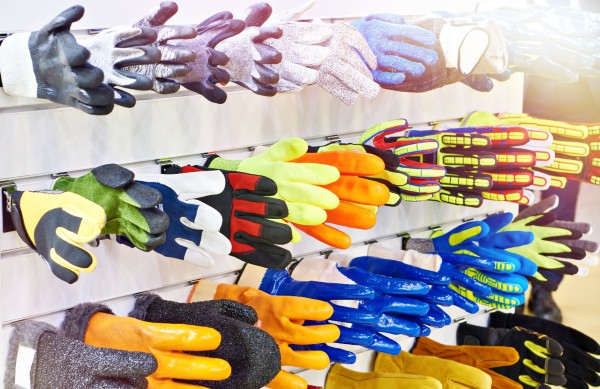Understanding Safety Glove Gauges6 October 2023 | Tania If you use protective gloves for your job, one thing that you might have come across is a mention of the gloves' gauge, but what exactly does this mean? Our guide to Understanding Safety Glove Gauges is here to help you understand the difference between a 7-gauge and an 18-gauge glove, and which is best for you!
What Does This Guide Cover?
What Does Gauge Mean?In technical terms the gauge of a glove refers to the number of stitches per square inch that go into making the glove. If, for example, you have a 7-gauge glove, this means that this glove has 7 stitches knitted per inch of that glove, for a 10-gauge glove it would be ten stitches, for a 13-gauge glove it would be 13, and so on. The higher the gauge, the more stitches that are knitted per inch. What this means in practical terms is that gloves with a higher gauge have a tighter knit, which reduces that thickness of the gloves (as they are created using a thinner yarn, typically) and increases the flexibility that the gloves provide. Gloves with a lower gauge are often thicker and more protective, however with new developments in the materials being used, this is no longer necessarily true. What Gauges Are Available?The most common glove gauge thickness classes available include: 7-gauge, 10-gauge, 13-gauge, 15-gauge, and 18-gauge. Please see below for a breakdown between these types. 7-Gauge Safety GlovesDue to the fewer stitches in 7-gauge gloves they are the thickest and usually the heaviest gloves, therefore are considered to be 'heavy weight gloves'. You may find it hard to find coated 7-gauge gloves, this is because these gloves cannot be easily coated due to the spaces between the stitches being too wide. Another drawback to these gloves is that they can reduce dexterity, and provide a lower tactile feel, which makes them difficult for use with intricate tasks. So what are their benefits? These gloves offer better density, cushioning, better longevity, and as they are usually made up of Kevlar or steel yarns, their thicker and heavier material combined with cut protection offer higher protection when compared to other gauges. You'll find these gloves offer the needed protection for tasks such as glass handling, plastic cutting, and other slicing operations. Check out our full range of 7-gauge gloves. 10-Gauge Safety Gloves10-gauge gloves aren't as thick as 7-gauge but still provide a considerable heft. These gloves are considered to be 'medium weight', and unlike 7-gauge gloves, can be coated with latex, nitrile, PU or PVC for better gripping of smaller parts and components. As the glove gauge number goes up, these gloves also provide better dexterity, allowing the hands to move easier. If you're in need of safety gloves that offer thicker denser Kevlar yarn for protection while providing better dexterity, 10-gauge gloves are an excellent choice. Check out our full range of 10-gauge gloves. 13-, 15-, and 18-Gauge Safety GlovesGloves that have gauges of 13 and higher are considered to be 'lightweight' and higher dexterity. The physical differences don’t change too drastically between 13, 15 and 18-gauge, but 18-gauge gloves are the lightest and most dexterous. These lightweight gloves are usually coated with a wide range of coatings to suit the job at hand, and offer industrial workers dexterity, tactility and cut protection of the same excellent level as lower gauge gloves. One drawback with these higher gauge gloves is that, due to their thinner composition, they may be less durable than gloves with a lower gauge, however this is not always the case. Check out our full range of 13-gauge, 15-gauge, and 18-gauge gloves. Want a visual look at how the different gauges perform? Check out our Glove Gauge Dexterity Test video below! Identifying Glove Gauges By Look and FeelWhen comparing 7- and 10-gauge gloves, with 13-, 15-, and 18-gauge gloves, the differences are instantly noticeable by looking at and feeling each one. Gloves with a lower gauge have a looser knit with more room in between their stitches, and feel coarser to the touch. Although you won't find it impossible to move your hands when wearing these gloves, picking up smaller objects like screws can be harder. When identifying higher gauge gloves you'll notice their tight knit construction, with very little room between stitches. When wearing these gloves you'll feel they are lighter, and that they offer dexterity when performing precision applications. Something else that is important to add is that glove gauges only refer to the liner of the gloves, and not the coating. A higher gauge glove is thinner and lighter, however any coating added, especially a double coating, can add thickness and weight to it making the glove appear thicker than the gauge it claims to be. Similarly, a glove that is lined for thermal protect will seem thicker even if it has a thinner gauge. Why Do Glove Gauges Matter?Now that you've got a better understanding of what glove gauges are, and the different ones available, you probably also have a better understanding of why they matter. For certain tasks, you need a level of protection that a thinner glove simply cannot provide. Gloves not only need to be able to protect the hands from chemicals, sharp objects, hot, or cold temperatures, but also be adequate for you to be able to do your job efficiently and safely. How Do I Choose The Right Gauge for Me?Choosing the right glove gauge will largely depend on the type of task you are undertaking. If, for example, the job you are doing includes of component handling, or picking up small pieces and parts, you won't find 7-gauge gloves much use as they will be bulkier than 18-gauge gloves, and not provide the dexterity you need to perform the task. Wearing 7-gauge gloves for tasks such as those can actually result in reduced productivity and errors. For tasks that involve sharp objects, glass, or blade handling, the level of cut resistance and puncture resistance they provide should always be a priority over the gauge they are. However, higher gauge cut gloves have an edge (no pun intended) over lower gauge cut ones, as higher dexterity will help prevent injury, by providing hands with a better sense of touch. Final ThoughtsFrom this blog, it is advised that the lighter and thinner the glove, the better dexterity you'll achieve. However, it is not to say that this a hard and fast rule, and should be taken as a general guide instead. With today's technology even some 'heavy weight' 7-gauge gloves have developed to be much more dexterous, enabling your hands to perform with more agility whilst staying protected. Generally you'll find that there isn't much difference in hand movement between 13 and 15 gauge gloves as they're close in the level of great dexterity they provide, however whilst wearing 18 gauge gloves you should be able to notice more of a difference in how your hands are able to move thanks to their ultra-lightweight construction. We hope this blog has been helpful in providing a better understanding on glove gauges, and helping you decide the glove gauge thickness you require. However if you're still unsure, or require more information on glove gauges, please feel free to leave a comment below or get in touch via the contact us page. | |









